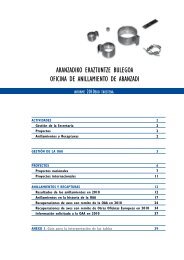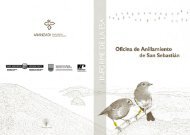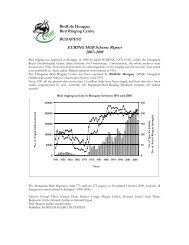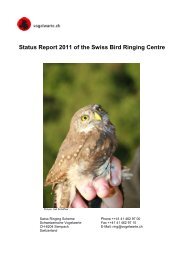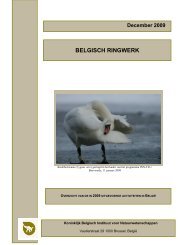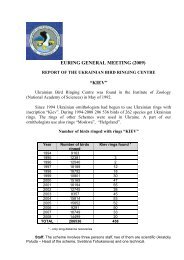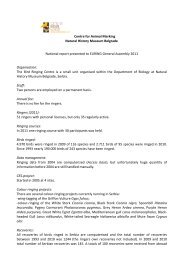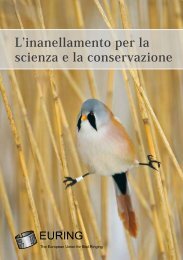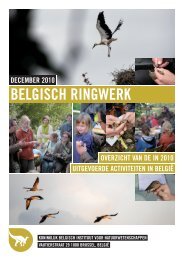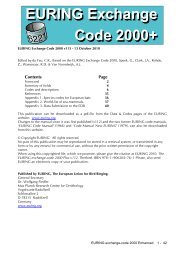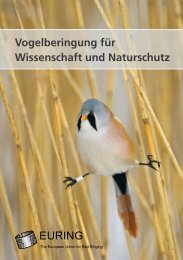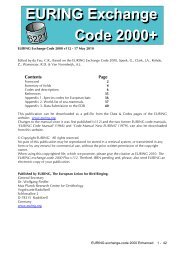Bird Ringing for Science and Conservation - The European Union ...
Bird Ringing for Science and Conservation - The European Union ...
Bird Ringing for Science and Conservation - The European Union ...
- No tags were found...
Create successful ePaper yourself
Turn your PDF publications into a flip-book with our unique Google optimized e-Paper software.
<strong>Bird</strong> <strong>Ringing</strong> <strong>for</strong> <strong>Science</strong> <strong>and</strong> <strong>Conservation</strong><br />
<strong>Bird</strong> <strong>Ringing</strong> <strong>for</strong> <strong>Science</strong> <strong>and</strong> <strong>Conservation</strong><br />
<strong>Bird</strong>-transmitted diseases<br />
When avian influenza virus of the H5N1<br />
type started its way from southeast Asia<br />
westwards into Europe in 2005, the public<br />
interest of movements of wild birds<br />
reached a peak as has never been seen<br />
be<strong>for</strong>e. Newspapers <strong>and</strong> broadcasting stations<br />
asked <strong>for</strong> bird migration maps showing<br />
possible links between avian influenza<br />
outbreak regions <strong>and</strong> <strong>European</strong> countries.<br />
Although the complexity of bird movements<br />
made it difficult <strong>for</strong> ornithologists<br />
to give simple answers many insights into<br />
bird migration phenology could be conveyed<br />
to the public. <strong>The</strong> results presented<br />
were largely based on recovery data from<br />
bird ringing.<br />
Not only mass media showed an increased<br />
interest in bird ringing results<br />
but also the <strong>European</strong> Commission <strong>and</strong><br />
many national administrations also became<br />
aware of the value of bird ringing<br />
<strong>and</strong> even funded bird ringing projects <strong>and</strong><br />
data analyses. This general interest in bird<br />
movements was driven by the assumption<br />
that wild birds – <strong>and</strong> especially waterfowl<br />
- are the main carriers of avian influenza<br />
<strong>and</strong> thus <strong>for</strong>m the main risk <strong>for</strong> the introduction<br />
of the disease into countries<br />
<strong>and</strong> into poultry holdings. Again, largely<br />
based on bird ringing results, ornithologists<br />
were able to show that there are<br />
discrepancies between the movements of<br />
birds <strong>and</strong> the movement of H5N1avian influenza<br />
virus. This demonstrates the important<br />
fact that movements of wild birds<br />
are not the only – <strong>and</strong> probably not the<br />
most important – source of avian influenza<br />
outbreak risk. Later, virologists reconstructed<br />
pedigrees of the outbreaks by<br />
analysis of parts of the viruses’ genomes<br />
<strong>and</strong> supported this point of view. One<br />
famous example was a Whooper Swan<br />
which was among the first victims of the<br />
avian influenza outbreak on the German<br />
isl<strong>and</strong> of Rugen. This bird was marked<br />
with an individually numbered neck col-<br />
Beat Walser<br />
More than half of<br />
the birds tested<br />
positive <strong>for</strong> H5N1<br />
avian influenza<br />
virus in the 2006<br />
<strong>European</strong> outbreak<br />
were Mute<br />
Swans. Thanks to<br />
ringing programs,<br />
the movements of<br />
this partly migratory<br />
species in Europe<br />
is fairly well<br />
known.<br />
Eurasian Teal is one of the 17 species <strong>for</strong><br />
which EURING has analysed recoveries<br />
in relation to High Pathogenicity Avian<br />
Influenza.<br />
lar attached in its breeding grounds in<br />
Latvia <strong>and</strong> it was seen alive more than<br />
two weeks be<strong>for</strong>e the outbreak in the<br />
Rugen area. This bird, <strong>and</strong> some others<br />
with individual marks, told scientists a lot<br />
about transmission <strong>and</strong> epidemiology of<br />
avian influenza virus <strong>and</strong> helped to develop<br />
effective, but not excessive measures<br />
of defence against this disease.<br />
Besides the spectacular H5N1 avian influenza<br />
outbreaks, scientists study many<br />
aspects of bird-transmitted diseases <strong>for</strong><br />
two main reasons. Firstly, birds can be<br />
highly mobile <strong>and</strong> effective hosts <strong>and</strong><br />
dispersers of diseases which may also effect<br />
plants, livestock, or humans. Besides<br />
Avian Influenza there is a wide range<br />
from West Nile Virus over Cercarial Dermatitis<br />
(“Swimmer’s Itch”) <strong>and</strong> Psittacosis<br />
(“Parrot Disease”) to humming bird-transmitted<br />
floral mites causing plant venereal<br />
diseases. Tracking of individuals, marked<br />
by bird rings, through space <strong>and</strong> time help<br />
us to underst<strong>and</strong> the ways of spread <strong>and</strong><br />
transmission of the disease. This helps to<br />
develop effective defences <strong>for</strong> the benefit<br />
of man, livestock <strong>and</strong> plants.<br />
Beat Walser<br />
Secondly, the easy accessibility of birds,<br />
the large background knowledge that<br />
is already available about bird biology<br />
<strong>and</strong> the potential of a large community<br />
of amateur ornithologists gathering in<strong>for</strong>mation<br />
make birds <strong>and</strong> their diseases<br />
ideal models <strong>for</strong> underst<strong>and</strong>ing the biology<br />
of hosts <strong>and</strong> parasites. With the<br />
help of thous<strong>and</strong>s of amateur ornithologists<br />
watching House Finches in their<br />
gardens in the United States, scientists of<br />
the Cornell University (Ithaca, NY) were<br />
able to follow, over a whole continent,<br />
the dynamics of mycoplasmal conjunctivitis,<br />
a new eye disease infecting the<br />
finches. <strong>The</strong>se observational data were<br />
completed by quantifying the effects of<br />
the disease on host demographic parameters<br />
via capture – mark – recapture modelling.<br />
By a similar approach – also requiring<br />
the individual ringing of birds<br />
– it is possible to investigate detection<br />
probabilities of disease carriers <strong>and</strong> assess<br />
disease prevalence. Both are important<br />
factors in underst<strong>and</strong>ing the co-evolution<br />
between a parasite (disease) <strong>and</strong><br />
its host.<br />
26<br />
27



